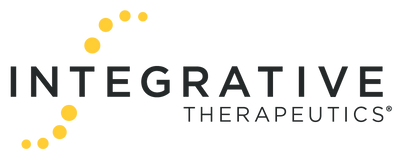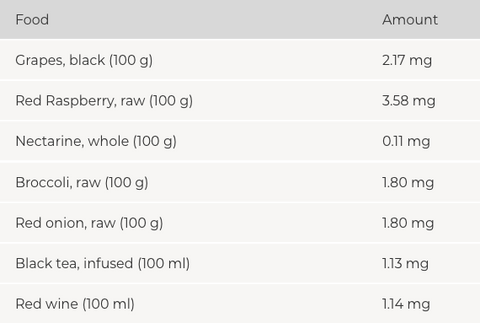Flavonoids are continuing to receive an ample amount of attention for their biological activities. Four types of flavonoids have been researched for clinical use and include: polyphenols derived from tea, quercetin and its diverse molecular cousins, citrus bioflavonoids, and proanthocyanidins found in grapes and certain pine species.1 Due to this attention, quercetin, one of the most abundant flavonoids found in food, has become perhaps the most studied flavonoid today.2
Benefits of Quercetin*
Quercetin has multiple influences on immune system function, aside from its most commonly known mast cell stabilizing activity.* Transcription factors involved in immune function are controlled by cytokines and quercetin appears to play a role.* Cytokines are a major part of the immune system and function as mediators within the immune system and hematopoiesis, which is the process of creating new blood cells.
In vitro evidence demonstrates that quercetin downregulates cytokine gene expression and production in peripheral blood mononuclear cells, particularly NFkappaB expression and production.*3,4 Quercetin can block angiogenesis in vitro and other signaling pathways including insulin-like growth factor, components of MAPK, and quercetin's free radical scavenging activity is attributed to several actions.*4
Quercetin's ability to scavenge and bind transition metal ions affects lipid peroxidation.* Free radical scavenging and reducing inducible nitric oxide synthase activity provides a supportive effect in circulation.* Quercetin additionally supports vitamin C absorption.*5 A double-blind, cross-over study evaluating the effect of 150 mg of quercetin daily demonstrated support of cardiovascular health.*6 In macrophages, quercetin is metabolized to the active aglycone form by the enzyme ß-glucuronidase which leads to reduced expression of lipopolysaccharide (LPS)-induced cyclooxygenase (COX)-2.7
Food Sources of Quercetin
Quercetin can be consumed through foods naturally containing quercetin or through supplementation. Quercetin primarily enters the diet as glycoside conjugates.8 One of the most abundant glycosidic forms present in plants is quercetin-3-glucoside (isoquercitrin), which is hydrolyzed in the small intestine and rapidly absorbed.8
Foods rich in isoquercitrin include leafy vegetables, broccoli, red onions, peppers, apples, grapes, black tea, green tea, red wine, and some fruit juices. The amount of quercetin received from food is primarily dependent on an individual's dietary habits. Research has found a typical Western Diet provides approximately 0 to 30 mg of quercetin per day, but a diet rich in fruits and vegetables was estimated to provide more.1 It is also important to note, that the food content of quercetin reflects variations in soil quality, time of harvest, and storage conditions.
Quercetin 3-O-glucodise (Isoquercitrin) Content in Food
*Created from Phenol-Explorer, Database on polyphenol content in foods.9
Supplementing Quercetin
It is common practice to evaluate dietary supplements in terms of food equivalence. In some cases it is not reasonable to consume food to reach a therapeutic or evidence-informed level found in dietary supplements while other times, it is a worthwhile exercise. If a supplement provides 40 mg of quercetin as isoquercitrin per day, an individual would need to consume the equivalent amount of quercetin from food, by eating approximately 8½ cups of fruits or vegetables that have a quercetin content of 2 mg per 100 grams per day. Although this is within the recommended daily intake for servings of fruits and vegetables, the average consumption in the United States is much lower. Identifying foods rich in quercetin and analyzing the diet are a couple of simple ways to estimate daily consumption of quercetin and determine any supplementation considerations.
Be mindful of the power of flavonoids and give special attention to quercetin and its applications. While a number of dietary assessment programs exist that evaluate everything from Calories, macronutrients, and micronutrients, these can be overwhelming for patients in many cases. Using an online database in relation to a specific food constituent can be an excellent exercise. Phenol-Explorer is one such online database. After evaluating a three-day food diary and noting, in this case, quercetin consumption can provide insight into whether or not lifestyle or dietary changes are required.
Know the Drug-Nutrient Interactions
As with many products on the market, drug and nutrient interactions can affect quercetin supplement recommendations.
REFERENCES
- Formica, J.V et al. 1995;33(12):106180.http://www.sciencedirect.com/science/article/pii/0278691595000771. Accessed October 28, 2016.
- D'Andrea G. Quercetin: Fitoterapia. 2015;106:256-71.
- Nair MP, Mahajan S, Reynolds JL, et al. Clin Vaccine Immunol. 2006 Mar;13(3):319-28.
- Boots AW et al. Eur J Pharmacol. 2008 May 13;585(2-3):325-37.
- Baghel SS et al. A Review of Quercetin World J Pharm Pharm Sci . 2012 1(1): 146-60.
- Yang F, Song L, Wang H, et al. Oncol Rep. 2015 Jun;33(6):2659-68.
- Ishisaka A et al. PLoS One. 2013 Nov 19;8(11):e80843.
- de Oliveira MR et al. Biotechnology Advances. 2016;34(5):532-49.
- Phenol-Explorer et al. http://phenol-explorer.eu/contents/polyphenol/293(Accessed October 18, 2016).



